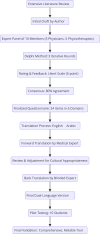Prevalence of obesity and associated risk factors among university students using the newly developed Student Lifestyle and Obesity Risk Questionnaire (SLORQ): a cross-sectional study
- PMID: 40547300
- PMCID: PMC12182051
- DOI: 10.7717/peerj.19556
Prevalence of obesity and associated risk factors among university students using the newly developed Student Lifestyle and Obesity Risk Questionnaire (SLORQ): a cross-sectional study
Abstract
Background: Obesity is a significant global health challenge, with a rising prevalence among young adults. University students are particularly vulnerable to lifestyle transitions and environmental influences. However, current assessment tools lack comprehensive multidimensional coverage of obesity risk factors, especially tailored to the cultural context of Saudi University students, representing a significant gap this study aims to address.
Objectives: To determine the prevalence of obesity among university students and identify behavioral, environmental, and demographic risk factors contributing to obesity via the Student Lifestyle and Obesity Risk Questionnaire (SLORQ).
Methods: This cross-sectional study was conducted from March to July 2024 and involved 907 students across 11 colleges at Majmaah University. Anthropometric data (height and weight) were objectively measured by the primary author, with students barefoot and wearing minimal clothing. The participants completed a self-reported validated, bilingual questionnaire (SLORQ) assessing six domains: physical activity, dietary habits, sleep patterns, weight management, metabolic health, and environmental factors. Data were analyzed using descriptive statistics (means, standard deviations), chi-square tests for categorical associations, and multiple linear regression for continuous predictors. Structural validity was assessed via principal component analysis (PCA); reliability included Cronbach's α (≥ 0.70) and intrarater reliability, intraclass correlation coefficients (ICC).
Results: Following data collection, statistical analyses revealed that the prevalence of obesity was 15% (n = 136), with 40% classified as overweight. SLORQ scores revealed inverse relationships between body mass index (BMI) and health behaviors, particularly dietary habits (r = - 0.912, p < 0.001) and physical activity (r = - 0.614, p < 0.001). No significant differences in BMI were observed based on gender, age, or region. Regression analysis indicated that diet, sleep, and physical activity accounted for most of the variance in BMI, highlighting their importance in obesity prevention. The questionnaire's internal consistency (Cronbach's α = 0.915) and intrarater reliability (ICC = 0.999) were assessed to ensure validity.
Conclusion: Obesity among university students at Majmaah University is influenced by poor dietary practices, inadequate physical activity, and insufficient sleep. These findings underscore the need for targeted health promotion campaigns and campus-wide interventions to address modifiable risk factors. The SLORQ has proven effective in assessing multidimensional obesity risk factors and can guide future research and policymaking.
Keywords: College students; Cross sectional study; Domains; Obesity; Prevalence; Questionnaire; Risk factors; Saudi Arabia.
©2025 Seyam.
Conflict of interest statement
The author declares that they have no competing interests.
Figures
Similar articles
-
Body image, obesity, and sexual coercion: Impacts on depression among students at a Nigerian university.PLoS One. 2025 Jun 17;20(6):e0319308. doi: 10.1371/journal.pone.0319308. eCollection 2025. PLoS One. 2025. PMID: 40526711 Free PMC article.
-
Strategies for enhancing the implementation of school-based policies or practices targeting risk factors for chronic disease.Cochrane Database Syst Rev. 2017 Nov 29;11(11):CD011677. doi: 10.1002/14651858.CD011677.pub2. Cochrane Database Syst Rev. 2017. Update in: Cochrane Database Syst Rev. 2022 Aug 29;8:CD011677. doi: 10.1002/14651858.CD011677.pub3. PMID: 29185627 Free PMC article. Updated.
-
Behavioral interventions to reduce risk for sexual transmission of HIV among men who have sex with men.Cochrane Database Syst Rev. 2008 Jul 16;(3):CD001230. doi: 10.1002/14651858.CD001230.pub2. Cochrane Database Syst Rev. 2008. PMID: 18646068
-
Prevalence of lower back pain and its associations with lifestyle behaviors among university students in the West Bank, Palestine: a cross-sectional study.Ann Med. 2025 Dec;57(1):2522974. doi: 10.1080/07853890.2025.2522974. Epub 2025 Jun 26. Ann Med. 2025. PMID: 40569050 Free PMC article.
-
Physical activity, diet and other behavioural interventions for improving cognition and school achievement in children and adolescents with obesity or overweight.Cochrane Database Syst Rev. 2018 Mar 2;3(3):CD009728. doi: 10.1002/14651858.CD009728.pub4. Cochrane Database Syst Rev. 2018. PMID: 29499084 Free PMC article.
Cited by
-
Biopsychosocial Determinants and Comorbid Risks of Obesity Among University Students: A Cross-Sectional Study.Healthcare (Basel). 2025 Jul 18;13(14):1736. doi: 10.3390/healthcare13141736. Healthcare (Basel). 2025. PMID: 40724762 Free PMC article.
References
-
- Al-Ghamdi S, Shubair MM, Aldiab A, Al-Zahrani JM, Aldossari KK, Househ M, Nooruddin S, Razzak HA, El-Metwally A. Prevalence of overweight and obesity based on the body mass index; a cross-sectional study in Alkharj, Saudi Arabia. Lipids in Health and Disease. 2018;17:1–8. doi: 10.1186/s12944-017-0646-8. - DOI - PMC - PubMed
-
- Al-Nozha MM, Al-Mazrou YY, Al-Maatouq MA, Arafah MR, Khalil MZ, Khan NB, Al-Marzouki K, Abdullah MA, Al-Khadra AH, Al-Harthi SS. Obesity in Saudi Arabia. Saudi Medical Journal. 2005;26(5):824–829. - PubMed
MeSH terms
LinkOut - more resources
Full Text Sources
Medical
Miscellaneous




